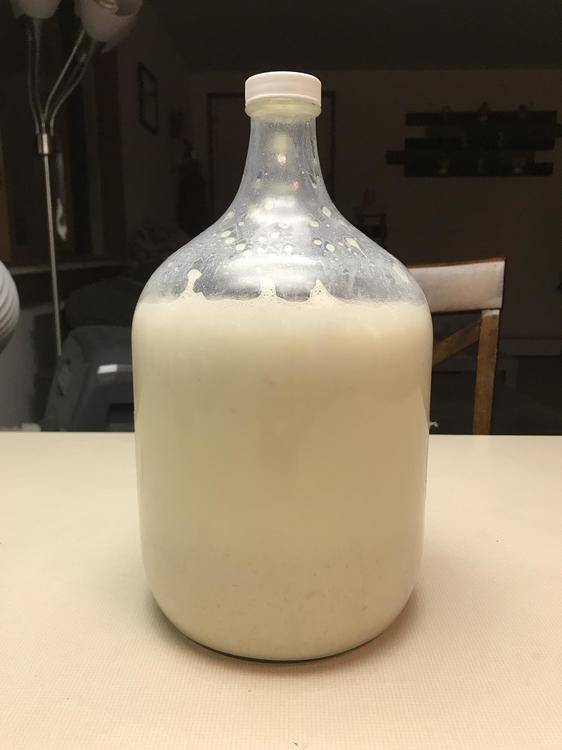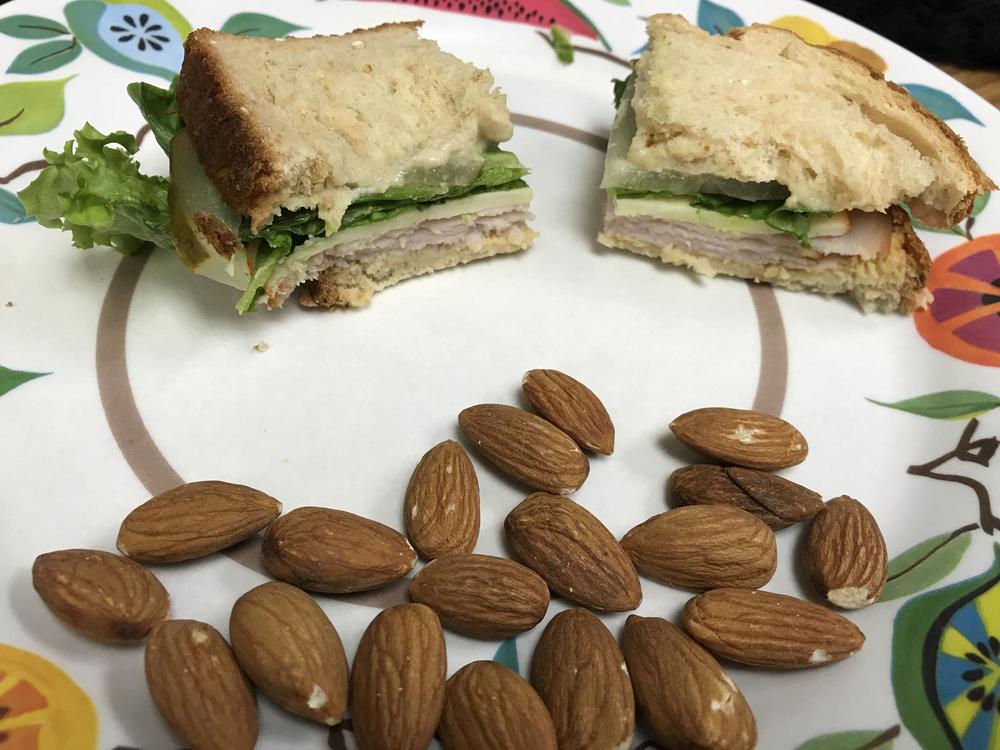-
Posts
15 -
Joined
-
Last visited
Contact Methods
-
Website URL
http://bryanquocle.journoportfolio.com
- LinkedIn Profile
Profile Information
-
Location
Madison, WI
Recent Profile Visitors
1,649 profile views
-
After looking at the two photos, I realize it's a little hard to see, but after 12 weeks, I got a bit of a faint amber-ish color from a white-cream color at week 1. I tried to highlight it with a filter on my camera, but it still looks pretty similar. The main difference has been that after 12 weeks, the mixture is a lot more fluid than before. At the week 1 mark, the ingredients were almost like a paste and didn't have much fluidity. Ingredients: ~725 grams (26 oz) of nonfat dry milk powder ~550 grams of rice koji 3 L of filtered water 500 grams + 150 grams of salt 1 tbsp fresh, unpasteurized miso 1. I mixed the rice koji, milk powder, and 500 gram of salt together dry so I could actually pour it all in the gallon jug. Wide-mouth containers are probably better for all of this, both with the exposure to oxygen, ease of stirring, and ease of pouring in ingredients. 2. I then poured the water into the jug, added fresh miso from the store to add salt-tolerant yeasts and bacteria, and shook the entire container hard to get everything to mix as much as I could. 3. I wrapped the top with a napkin and rubber band so I could let the mix breathe. I've noticed that there's a smell of stinky feet at the top, but when I mix the whole thing, it subsides. I'm thinking that I have something growing on top that's giving off the smell, and it does get stronger if I don't stir. Otherwise, it's a pretty neutral odor, almost with a hint of vinegar in the background. 4. I've been keeping the jug in a dark warm place for the past 12 weeks, but would love to experiment with keeping it in the sun. It's too bad it's cold in Wisconsin, but maybe when the spring rolls around I'll keep the jug outside. 5. Today, I just added another 150 grams of salt because I realized I didn't quite have enough salt considering all of the material in there (I was definitely way under 20% w/w, and under the 15% margin that seems to be important to keep things safe) I'm hoping that in the next 6 to 9 months, I'll start to notice a stronger change in the color. I don't expect to see a real darkening without sunlight, but I'm hoping at least to see what happens. I did try to taste the fermenting paste/sauce a few weeks ago. Nothing earth-shattering - it was actually a little mild, but then again I didn't try it out with anything. I realize this isn't technically a 'soy sauce' but I'm hoping it'll be helpful to learn about the process with rice koji. I might just try the wild mold method on those soy cakes too and see what I come up with. While I know that you need koji-kin (mold spores) to propogate and grow koji mold, I'm wondering if there's a way to hack the process by taking pre-inoculated rice koji (from the store) and force it to grow on a new substrate. I've always wondered if there's a way to get the koji to spread; at the same time, I also think once the koji goes in the refrigerator, it starts to die and leave behind its enzymes (which are the real workhorses of flavor transformation). But this is all hearsay and I haven't read anywhere, research or otherwise, about the changes to how koji mold interacts with its environment once it gets dried and stored for shipping. There's obviously a reason why koji-kin is the way to go with starting these fermentations, but molds can also grow by fragmenting off the main body and regrowing into a new mold body, like growing a plant from clippings.
-
Here are a few more recipes on non-plant koji garums from the Nordic Food Lab: http://nordicfoodlab.org/blog/2012/03/umami-arising-from-salt-rich-fermentations http://nordicfoodlab.org/blog/2013/6/koji-chovy http://nordicfoodlab.org/blog/2016/3/18/fractioning-insect-garums http://nordicfoodlab.org/blog/2012/07/mad-2-finding-the-deliciousness-of-insects
-
Thank you - we haven't had much snow yet, but looking forward to some cozy nights with hot chocolate by the fireplace. And I'll be sure to post pictures of those pickles.
-
That's super cool, congrats to your friend on a successful mission!
-
Keep us posted! I'm fascinated by alternative garums/koji ferments, so would love to hear how the beef turns out. From what I've read about koji, you lose somewhere in the ball park of 50% of enzyme activity as soon as the manufacturer dries the koji and throws the product in the fridge. Accounting for weight loss through drying, I imagine if you go 1:1 for beef to koji ratio, there shouldn't be too much of an issue. I went a little higher compared to other recipes in my ferment just in case; I think your only issue would be that the final product might be a little sweeter from extra rice, but hopefully that gets fermented off by the salt-tolerant yeasts. I'd say you can add fresh miso to let them grab a foothold, otherwise it might take longer for them to inoculate from the air. Disclaimer: I'm not a food safety expert. How much salt are you using? If you're above 18% total weight, I don't think you need to worry about hitting the danger zones because the salt content would keep everything safe. For what it's worth, I think most garums and sauces are made just a bit north of room temperature - going 140 F might trash the koji enzymes (and any fermenting microbes) if you're going for several months, vs. if you were doing sous vide and only needing the enzymes for +3 days. I wish I had a copy of the Noma Guide to look through and see what they have to say about garum, I only have their posted articles to work off of. There's a Japanese paper (literally, most of it is in Japanese sorry about that, couldn't find a translation I found an English translation!) that says in the abstract that their pork meat sauce (shishibishio) was fermented at 30 C (86 F) for 6 months. So I think you should be fine from a food safety standpoint if you wanted to keep things closer to room temperature without needing temperature and humidity controls. You could raise to 37 - 40 C to give the enzyme and bacteria a speed boost, but that's about it. The only thing I can think of is to keep exposing the ferment to oxygen when you mix to prevent C. botulinum from forming, but your salt should mostly take care of that. I hope that helps! shishibishio-meat-sauce-paper-ENGLISH.pdf
-
Everyone has such beautiful-looking meals... My attempt at beautifying my turkey-meat sandwich with sliced muenster, hummus, Dijon mustard, and pickles with a side of unroasted almonds.
-
@suzilightning Street tacos. I can't have enough of them with a delicious salsa. Madison has a few excellent eateries, but it's hard to compare to 1. Mexico itself, and 2. California. We gave them a try this past weekend with our friend, who made a great marinade with orange juice and spices, but I do miss that authentic flavor that I can't seem to replicate at home. I do want to try making al pastor at some point, but I'm waiting for fresh pineapples to be back in season.
-
@chromedome That's hysterical. My wife got a kick out of that.
-
Just learned about tea recently, and been trying to buy high quality leaves. I went with jasmine green tea pearls from a local tea shop (Macha Tea Company for any Madisonites out there), and they were incredible. We bought some for my mother-in-law for Christmas. I then went ahead and bought some on Amazon, the highly rated ones. Can't say I was impressed (they were just decent), I think I've been spoiled
-
My wife and I took the plunge and bought ourselves a Le Creuset 5 qt Dutch Oven. We got it from a wholesaler, so quite the deal. Still pretty much blasted our funds for the year, but has been totally worth it. A new Vitamix blender would be AMAZING.
-
@Okanagancook Appreciate the read, I hope it wasn't too much of a rabbit hole! That's probably one of my better ones @kayb I do feel fortunate to have quite the cheese selection here. Sadly, I feel I haven't made quite the effort to truly explore the amazing cheese diversity of Wisconsin - tasting recommendations are always welcomed by me and my wife! @Kim Shook Wonderful, I'm excited to get them. And that does sound like a lot of fun, maybe I can entice her to join. She definitely has a better eye (and tongue) on the actual aesthetics of food...
-
Thank you for the warm welcome. It can be easy to get sidetracked by all the amazing things out there on food We try to share the kitchen as much as we can. I would say my wife does most of the actual directing in the kitchen - she finds the recipes, puts together the meal plans, etc. I tend to be the experimenter, for better or worse. Most nights we try to do a 50-50 share of the work. We're both big fans of Vietnamese cuisine (my background, she's Romanian-Israeli). So far, it's mostly been variations on pho, rice dishes, marinated tofu, noodle salads, and broths, soups, and stews. We used to do a lot of chilis before for the winter, but started moving away towards fresher cuisine. We also enjoy a bit of dabbling in Japanese and Chinese cuisine - I especially like to make Japanese tsukemono pickles. And sounds good, I'll be sure to take a look at the posting forum to get a better feel for the way things work around here. Thank you again.
-
Okay, so I have been playing around with alternative 'soy sauces' after reading about the experimentation being done at the Momofuku Lab using inoculated koji rice. I was particularly impacted by the 'bonji' that they produce using rye grains. I spent the summer at a cheese plant, and talked to one of the master cheesemakers about what they do with some of the leftover cheeses. Sometimes they'll take it and add industrial enzymes to break down the protein into umami-flavored amino acids, which is basically the way to make processed cheese. That got me thinking - I looked into anything dairy combined with koji enzymes, and pulled up one of these posts by Rich Shih on dairy miso. He was able to create parmesan-like flavors with yogurt and whey protein powder. So I got super intrigued. I took the cheapest form of dairy solid with the highest protein I could find (in this case, nonfat dry milk powder, 725 g) and combined it with about 500 g of koji rice from the nearby oriental store (Cold Mountain brand), then submerged it in 3 L of 20% brine. I then added about a tablespoon of fresh miso from the store to inoculate the mix with salt-tolerant yeast and bacteria. It's been fermenting since August. After three months, the mix has gone from light, creamy color to a hazy brown and smells a little like cow. I'm thinking about filtering it today and letting it ferment for another three months before trying it in cooking. After a few taste trials, it definitely has a nice, soft saltiness that wasn't expected (no cheesy flavor here). I'm thinking since NFDM powder is about 55% lactose, that the flavor I'm getting is a slight sweetness in combination with the broken down proteins and salt. Not sure yet if I like it, since I'm lactose intolerant! I've since learned that fermenting lactose is a slow process for many microbes, and probably many times slower when the concentration is somewhere in the range of 125 g/L (maximum solubility of lactose in water is 195 g/L). I'll attach before and after photos later today.
-
This is such an exciting thread; I think I might just have to dive in at some point before the end of the year... @Sheryl236, I've been wondering that too. I did a little digging, and it seems like the main yeast that's responsible for developing flavor in soy sauce fermentation (Z. rouxii) might actually clear out the mycotoxins left over in the fermenting brine: https://www.ncbi.nlm.nih.gov/pmc/articles/PMC5308274/ I'm by no means a food safety expert! But it's promising that maybe over the 6 months to 1 year of fermenting the soy sauce, you're probably going to see some decrease in mycotoxins. @Fermentfanatic, I've been seeing the numbers 18-20% (by weight) a lot here and on other articles/posts on the internet. My guess has been that you have to add the weight of soybeans and flour that you want to the weight of water that you're using (volume = weight for water, so 1 L or 1,000 mL = 1,000 g), then multiply by 0.18 or .2 to give you the amount of salt total. Example: 4 L water + 250 g soybeans + 250 g flour = 4500 g total (approx.) 4500 * 0.18 = 810 g salt 4500 * 0.2 = 900 g salt
-
Hello all! My name is Bryan, thank you for allowing me to join. I'm very excited to explore the world of food in more detail. I'm originally from California but am now a transplant to Wisconsin. The winter is still an adjustment, even after 3+ years living here (has it really been that long?!) I'm currently studying food science at UW-Madison after making a tiny leap from studying straight chemistry for many years - I realized that I had a big passion for food after I met my wife and we started exploring in the kitchen together. I stumbled on eGullet after procrastinating on my work and getting fixated on the homemade soy sauce thread. I have a particular fondness for soy sauce fermentation and was amazed to see people actually giving it a shot at home. This is a real adventurous bunch! On the side, I do a little consulting with small food businesses and would be happy to lend a technical hand anywhere I can. I also do some food science writing for fun, with a particular interest and love for all things involving flavors, fermentation, and chemistry. I also have strong opinions about soy and fish sauces 😉. Thanks again, and looking forward to exploring and contributing!








.thumb.jpeg.51f5d2ba33b5afd3fc040affd9c2bd9c.jpeg)

